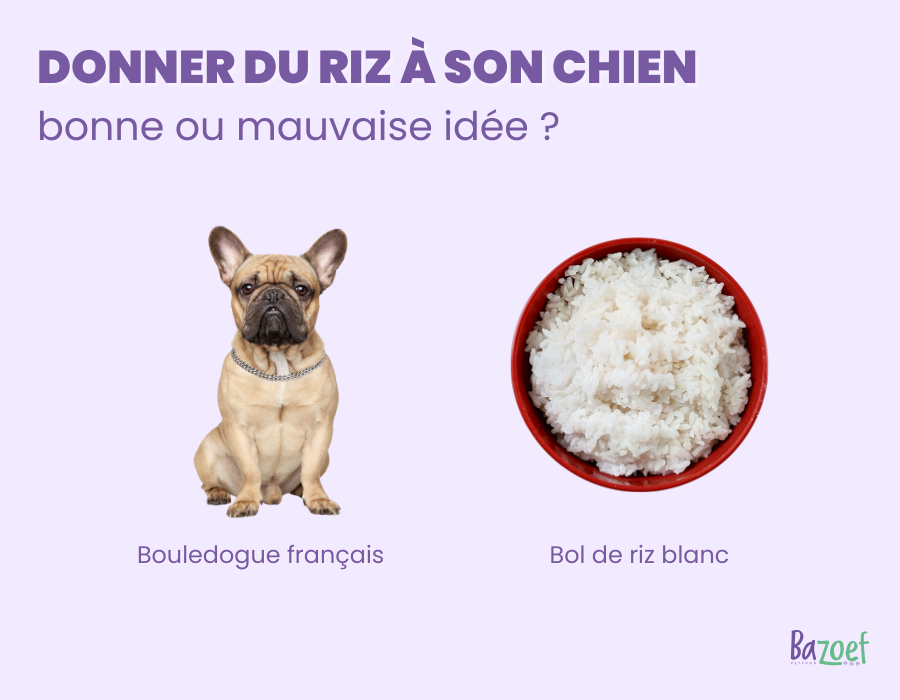In a world where dog nutrition is constantly evolving—with options ranging from premium kibble to homemade meals and grain-free diets—one question keeps coming up: can (or should) you feed rice to your dog?
Rice has long been a go-to ingredient, especially during digestive upsets, but in recent years, it has gotten a bit of a bad reputation.
However, when used correctly, rice can offer real health benefits for our four-legged companions.
In this complete guide, we’ll explore the key advantages of feeding rice to dogs—along with the situations where it might be better to leave it out.
Benefits of Rice for Dogs
1. Easy to Digest
Rice—especially white rice—is widely known for its high digestibility. When cooked plainly in water, without seasoning, it’s often used as a transitional food during digestive upset in dogs.
For example, when a dog experiences temporary diarrhea or mild vomiting, vets often recommend a simple mix of well-cooked white rice and lean meat like chicken.
Sensitive breeds such as the Cavalier King Charles, Shih Tzu, or French Bulldog—who are prone to delicate stomachs—often benefit from gentle rice-based meals to help rebalance their gut flora.
This approach gives the digestive system a break without sacrificing essential caloric intake.

2. Quick Source of Energy
Rice is rich in easily digestible carbohydrates, making it a fast-acting energy source.
This can be especially helpful for active dogs that need an energy boost—like Border Collies or Australian Shepherds, who are often engaged in agility training or long walks.
3. Hypoallergenic
Rice is considered one of the least allergenic grains. It’s often used in hypoallergenic formulas for dogs with skin conditions or food intolerances.
Unlike wheat or corn, rice rarely triggers digestive or skin reactions.
Breeds like the West Highland White Terrier or Shar Pei—both prone to food allergies—typically tolerate rice well.
When a dog shows signs of persistent itching or chronic ear infections, vets often recommend switching to a simple diet, and rice is frequently a reliable base ingredient in that transition.

4. Regulates Digestive Transit
Depending on the type, rice can have opposite effects on digestion. White rice, which is low in fiber, tends to slow down the digestive system and is ideal when a dog has loose or watery stools.
On the other hand, brown rice (whole grain), which is higher in fiber, helps stimulate digestion and can support dogs suffering from constipation in regaining a regular bowel rhythm.
5. Ideal for Homemade Diets
Rice is a simple, affordable, and easy-to-prepare ingredient that fits well into a balanced homemade diet.
It serves as an excellent base when combined with animal proteins, cooked vegetables, and a source of quality fats.
Its mild taste is appealing to most dogs—even the picky eaters.

How Much Rice Should I Feed My Dog?
While rice can support your dog’s digestive health, it’s important to serve it in the right proportions.
Too much rice can throw off nutritional balance—especially if it replaces essential proteins or fats in the diet.
The right amount depends on several key factors:
- Your dog’s weight
- Activity level (sedentary, moderate, active)
- Purpose of the rice (temporary use for digestion vs. regular part of a homemade diet)
- Type of rice (white, brown, basmati...)
- Ratio in the overall diet – rice should generally not exceed 20–30% of total daily calories.
📊 Suggested Daily Amounts of Cooked White Rice
| Dog’s Weight | Occasional Use (e.g. for digestion) | Balanced Homemade Diet (max/day) |
| 5 kg | 30–50 g | 80–100 g |
| 10 kg | 50–80 g | 120–150 g |
| 20 kg | 90–120 g | 180–250 g |
| 30 kg | 120–160 g | 250–350 g |
| 40+ kg | 160–220 g | 350–450 g |
These amounts are estimates for healthy adult dogs. Always adjust based on your dog’s age, activity level, health condition, and food type—and consult your vet for a personalized feeding plan.
Don't forget:
- For diabetic, overweight, or very inactive dogs, rice portions should be even smaller.
- Rice fills the belly but doesn’t provide protein—never feed it on its own as a complete meal.
- When in doubt, consult a veterinary nutritionist to properly balance a homemade diet.
Feeding rice can be helpful, but only when used wisely and in moderation.
For a homemade meal, rice should always be combined with animal proteins (such as insect protein, chicken, beef, or fish), cooked vegetables, and a source of high-quality fats (like canola oil or salmon oil).
What Types of Rice Can I Feed My Dog?
Not all types of rice are equally suitable for dogs. Some are easier to digest, while others are higher in fiber or release energy more slowly.
Here’s a breakdown of the most common rice varieties you can feed your dog, along with their benefits and key precautions.
📊 Comparison Table – Rice Types for Dogs
| Type of Rice | Digestibility | Fiber Content | Glycemic Index | Suitable for Regular Use |
| White rice | ✅ Very good | ❌ Very low | ❌ High | ✅ Yes, in moderate amounts |
| Brown rice | ❌ Moderate | ✅ High | ✅ Moderate | ✅ Yes, if well cooked |
| Basmati rice | ✅ Good | ❌ Low | ✅ Moderate | ✅ Yes, as part of a varied diet |
| Jasmine rice | ✅ Good | ❌ Low | ❌ High | ❌ Best used occasionally |
| Wild rice | ❌ Low | ✅ Very high | ✅ Moderate | ❌ Rarely recommended |
Additional Notes:
- Digestibility: The more digestible the rice, the easier it is for your dog to absorb nutrients without upsetting their stomach—especially important for sensitive dogs.
- Fiber content: Can help regulate digestion and support satiety, but should be adapted to your dog’s tolerance.
- Glycemic index: A higher index leads to a quicker spike in blood sugar. Best limited in overweight or low-activity dogs.

White Rice
White rice is the most commonly used type for dogs, especially during digestive upsets. It’s had the bran and germ removed, making it very digestible and low in fiber.
It’s often recommended in cases of diarrhea, vomiting, or during dietary transitions.
Its quick cooking time and soft texture make it an excellent temporary base to soothe an irritated stomach.
However, due to its high glycemic index, it should be fed in moderation—particularly for dogs that are inactive or prone to weight gain.

Brown Rice (Whole Grain)
Brown rice retains its bran and germ layers, making it higher in fiber, vitamins, and minerals. It’s a great addition to a homemade diet when you want to support digestion or increase satiety.
However, it’s less digestible than white rice. It requires longer cooking and should be introduced gradually to avoid digestive discomfort such as gas or bloating.
It’s less suitable for very young, elderly, or sensitive dogs.
Basmati Rice
Basmati rice is a variety of white rice with a moderate glycemic index, making it a good middle ground between digestibility and slow energy release.
It’s generally well tolerated by most dogs and has a natural aroma that can appeal to picky eaters.
Basmati is well-suited for balanced homemade meals, especially when you want to provide steady energy without causing blood sugar spikes. Its light, fluffy texture also makes it easy to chew.

Jasmine Rice
Jasmine rice is a fragrant variety with a soft, fluffy texture after cooking.
It’s highly digestible, but has a higher glycemic index than basmati. It can be offered occasionally to dogs that reject bland food or have a poor appetite.
Due to its high carbohydrate content, jasmine rice should be used in moderation and always paired with a good source of animal protein to ensure a balanced meal.
Wild Rice (Not Recommended)
Despite its name, wild rice comes from a different aquatic plant and is not a true rice. It’s very high in fiber and has a firmer texture.
This makes it difficult to digest for most dogs—especially if not cooked thoroughly.
It can be used occasionally and in very small quantities as part of a varied homemade meal, but it’s not suitable as a regular base. Wild rice is rarely used in dog nutrition for good reason.
What About Rice in Kibble? Here's What You Should Know
Rice isn’t just used in homemade meals—it’s also found in some high-quality kibble formulas, where it serves a specific purpose.
But not all kibble is created equal: what matters is the amount, the type of rice, and—most importantly—the overall balance of ingredients.
In a well-formulated kibble, rice isn’t just filler—it provides a digestible energy source that works in harmony with animal proteins and dietary fiber to support your dog’s health.

Rice in Kibble: A Digestible Carbohydrate
White rice is one of the few carbohydrates that are well tolerated by most dogs.
In kibble, it serves several useful functions:
- Improves the overall digestibility of the recipe
- Provides quickly absorbable energy
- Helps moderate fiber intake, which is helpful for dogs with sensitive digestion
Unlike corn or wheat—often used as cheap fillers—white rice is more digestible and less allergenic, making it a great choice for dogs with sensitive stomachs.
How Much Rice Should There Be in Balanced Kibble?
In high-quality kibble, rice is used in measured amounts, typically between 10% and 20%.
This helps avoid carbohydrate overload while keeping the food digestible and nutritionally balanced.
⚠️ If a kibble lists 30–40% cereal content as its first ingredient, it's a red flag—meaning rice or another grain dominates the formula, which is best avoided.
So, Where Do Bazoef Kibble Stand?
Bazoef kibble is carefully formulated with a clear, simple nutritional philosophy—designed to support your dog’s health without unnecessary fillers or confusing labels.
Let me know if you'd like help comparing Bazoef formulas or choosing the right one for your dog's needs!

In Bazoef kibble, rice is included in a thoughtful and balanced way, as part of a recipe built around digestibility and functional ingredients:
- Dried insect protein (23%) – A hypoallergenic, highly digestible animal protein source.
- White rice (14%) – Provides easily absorbed energy without overloading the formula.
- Naked oats (14%) & peas (14%) – Rich in fiber and complex carbs to support healthy digestion.
- Canola oil (7%) – A natural source of omega-3 and omega-6 fatty acids.
- Pumpkin, chicory, brewer’s yeast, MOS, carrot, apple, cranberry – Functional ingredients that support digestion, immunity, and overall vitality.
This careful blend makes Bazoef a solid option for dogs needing a well-balanced, gentle, and nutritious diet. Let me know if you'd like a breakdown of how this compares to other brands!
💡 With 14% white rice, Bazoef kibble strikes a smart balance between digestibility and carbohydrate control—without excess grains or unnecessary additives.

Conclusion
Rice can be a valuable addition to your dog’s diet—if chosen wisely and used in the right amount.
In moderation, it’s digestible, energy-rich, and especially helpful in certain situations, such as during digestive issues or as part of a balanced homemade meal.
In kibble too—like in Bazoef recipes—rice has a role to play.
Not as a filler, but as a digestible energy source, working alongside high-quality proteins and functional ingredients to support your dog’s health and vitality.



